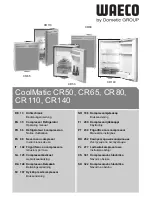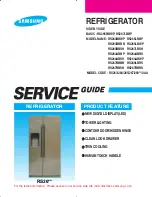
19
Hints for freezing
To help you make the most of the freezing process,
here are some important hints:
•
the maximum quantity of food which can be
frozen in 24 hrs. is shown on the rating plate;
•
the freezing process takes 24 hours. No further
food to be frozen should be added during this
period;
•
only freeze top quality, fresh and thoroughly
cleaned, foodstuffs;
•
prepare food in small portions to enable it to be
rapidly and completely frozen and to make it
possible subsequently to thaw only the quantity
required;
•
wrap up the food in aluminium foil or polythene
and make sure that the packages are airtight;
•
do not allow fresh, unfrozen food to touch food
which is already frozen, thus avoiding a rise in
temperature of the latter;
•
lean foods store better and longer than fatty
ones; salt reduces the storage life of food;
•
water ices, if consumed immediately after
removal from the freezer compartment, can
possibly cause the skin to be freeze burnt;
•
it is advisable to show the freezing-in date on
each individual pack to enable you to keep tab of
the storage time;
HINTS
Hints for refrigeration
Useful hints:
Meat (all types):
wrap in polythene bags and place
on the glass shelf above the vegetable drawer.
For safety, store in this way only one or two days
at the most.
Cooked foods, cold dishes, etc..:
these should be
covered and may be placed on any shelf.
Fruit and vegetables:
these should be thoroughly
cleaned and placed in the special drawer(s)
provided.
Butter and cheese:
these should be placed in
special airtight containers or wrapped in aluminium
foil or polythene bags to exclude as much air as
possible.
Milk bottles:
these should have a cap and should
be stored in the bottle rack on the door.
Bananas, potatoes, onions and garlic, if not
packed, must not be kept in the refrigerator.
Hints for storage of frozen food
To obtain the best performance from this appliance,
you should:
•
make sure that the commercially frozen
foodstuffs were adequately stored by the retailer;
•
be sure that frozen foodstuffs are transferred
from the foodstore to the freezer in the shortest
possible time;
•
not open the door frequently or leave it open
longer than absolutely necessary.
•
Once defrosted, food deteriorates rapidly and
cannot be refrozen.
•
Do not exceed the storage period indicated by
the food manufacturer.
•
The symbols on the drawers show different types
of frozen goods.
The numbers indicate storage times in months for
the appropriate types of frozen goods. Whether
the upper or lower value of the indicated storage
time is valid depends on the quality of the foods
and pre-treating before freezing.
•
do not put carbonated liquids (fizzy drinks,
etc.) in the freezer compartment as they may
burst.
22
CUSTOMER SERVICE AND SPARE PARTS
If the appliance is not functioning properly, check that:
•
the plug is firmly in the wall socket and the mains
power switch is on;
•
there is an electricity supply (find out by plugging
in another appliance);
•
the thermostat knob is in the correct position.
•
If there are water drops on the bottom of the
cabinet, check that the defrost water drain
opening is not obstructed (see “Defrosting”
section).
•
If your appliance is still not working properly after
making the above checks, contact the nearest
service centre.
To obtain fast service, it is essential that when you
apply for it you specify the model and serial number
of your appliance which can be found on the
guarantee certificate or on the rating plate located
inside the appliance, on the bottom left-hand side.
Noise due to the adjustment of the unit’s structure
Possible noise sources that are
easy to eliminate:
The appliance is not well levelled:
Simply adjust the levelling foot.
The appliance touches adjacent units:
Move the units away
Interior accessories are not fixed securely:
Remove the accessories and put them back properly
Bottles and/or receptacles touch each other
inside the appliance:
Separate them.
Tic
Tic
Hereunder you will find some normal causes of noise
that do not jeopardise normal functioning of the
product.
Compressor motor noise
Noise caused by the gas circulating in the
refrigerating circuit pipes
Blubb
Blubb
Brrrr
Noisiness


























